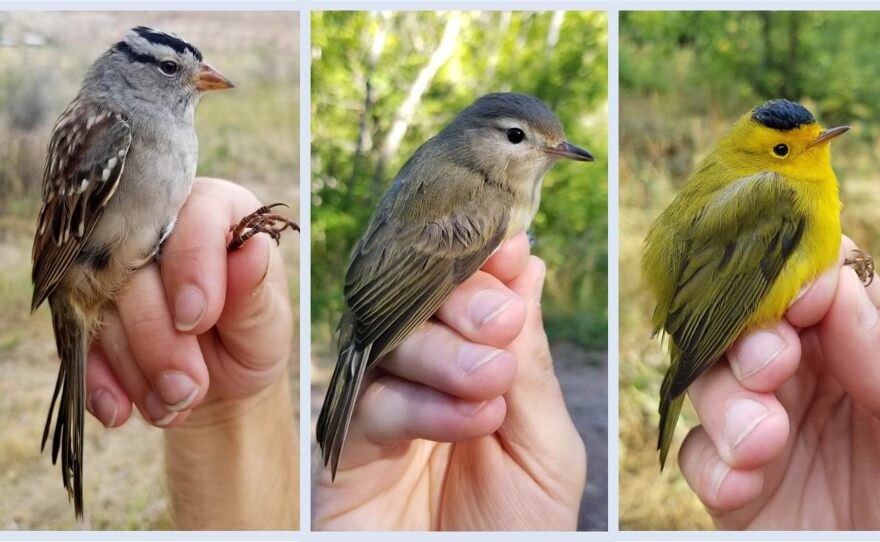Wildfire season is getting worse and humans aren’t the only ones who suffer. Recent research from the University of Utah explores how wildfires affect migratory birds across the western United States.
Kyle Kittelberger is a PhD student at the University of Utah. He studies how global change, including climate change and habitat degradation, influences migratory birds. Of particular interest to Kittelberger are wildfires and how they affect the movements and population trends of these bird species during fall migration.
Wildfires in North America are getting progressively worse over time, both in severity and in extent. While the reasons are complex, these worrying trends are largely due to a combination of poor wildfire management practices and hotter temperatures as climate change impacts increase.
“They're more severe, they're lasting for longer and they are burning in areas where they perhaps did not previously burn…so the temperature increases allowing for more conducive conditions for fires to really grow and expand. And so they get to this size where it's really difficult to control,” Kittelberger explained.
2020 was North America’s second worst wildfire season in recent history. In the western United States alone, over ten million acres burned. At about the same time these wildfires were at their worst, Kittelberger noticed an influx of stressed and dying birds at his research site near Moab. Other researchers across the West noticed dead or dying birds at their sites as well–even more than Kittelberger had seen.
“We started to see these alarming signs with the migratory birds in the West,” Kittelberger said. “We got these huge mass mortality events, with the peak of the mortalities occurring in early to mid-September...these were largely occurring in New Mexico, but also throughout states in the southwest. So, Colorado, here in Utah, we were having mortalities.”
Researchers collected over ten thousand dead birds from the 2020 mortality event. However, it’s probable that many birds were missed simply because they died in areas that weren’t easily accessible to humans.
“It's likely that upwards of 100,000+ could have perished across the Southwest, just in regions where people were not out finding these dead birds,” Kittelberger said.
To Kittelberger, the timing between widespread bird deaths and the peak of the 2020 wildfire season seemed to be more than a coincidence. All of the dead or dying birds Kittelberger had found were emaciated, so much so that they had burned through their flight muscles in addition to body fat, a sign the birds were already stressed well before their deaths. Intrigued, he set out to explore whether these wildfires were an underlying cause of the massive bird die-off, and how wildfire affects migrating birds generally across the western United States.
Using data from birds captured at his research site near Moab, he found that at an annual scale, wildfires had little noticeable effect on the number of birds researchers captured or how healthy they were. However, when he zoomed into the fall of 2020 and examined daily and weekly effects of the wildfires, he noticed bird health decreased as fires worsened.
“I found that with more acres burning, there were more birds with lower body masses…my suspicion right now is that birds may be starting their migration earlier than normal when there is a lot of wildfire smoke…and so birds may not have the proper fat reserves on their bodies for their long distance journeys, which could result in them being emaciated.”
Kittelberger also found a significant increase in the number of birds captured at the Utah banding station a week after wildfire severity peaked. Kittelberger pointed to a study tracking greater white-fronted geese that suggests birds may have altered their migratory paths to avoid the thick wildfire smoke as they journeyed south for the winter.
“Satellite tracking data show that these fires had caused these birds to significantly alter their flight paths. They avoided flying through the fire, they rafted on the water until conditions were better, they flew above the smoke, they flew way out of range into a part of the state where this subspecies had never been recorded before,” Kittelberger detailed.
With so many stressed birds passing through his research site, Kittelberger and his coauthor, Colorado State graduate Megan Miller, realized the traditional way of measuring a bird’s body fat as a health indicator wasn’t enough. They devised an emaciation scale that takes into account whether birds have started to burn through their muscles in addition to fat–a telltale sign a bird is starving.
“It's a more effective and accurate method for assessing body condition of birds, especially in really stressed individuals in comparison to using something such as fat because a lot of birds can have zero fat and still be perfectly healthy,” Kittelberger said.
Kittelberger hopes their method will help other researchers across the country better understand how healthy migrating birds are in the future.
Read Kittelberger’s study here.





